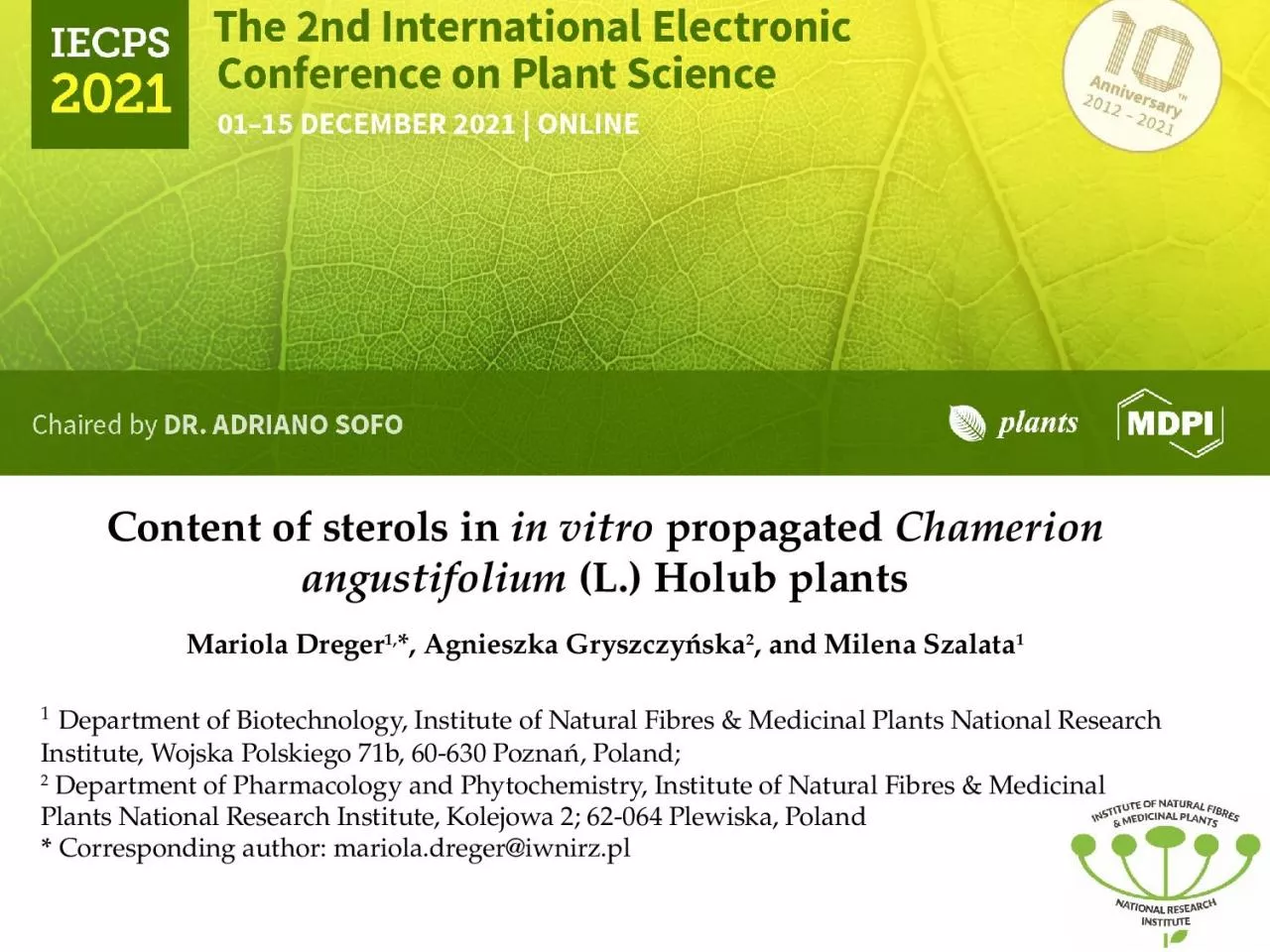

propagated Chamerion angustifolium L Holub plants Mariola Dreger 1 Agnieszka Gryszczyńska 2 and Milena Szalata 1 1 Department of Biotechnology Institute of Natural Fibres ID: 934538
Download Presentation The PPT/PDF document "Content of sterols in in vitro" is the property of its rightful owner. Permission is granted to download and print the materials on this web site for personal, non-commercial use only, and to display it on your personal computer provided you do not modify the materials and that you retain all copyright notices contained in the materials. By downloading content from our website, you accept the terms of this agreement.
Slide1
Content of sterols in in vitro propagated Chamerion angustifolium (L.) Holub plantsMariola Dreger1,*, Agnieszka Gryszczyńska2, and Milena Szalata11 Department of Biotechnology, Institute of Natural Fibres & Medicinal Plants National Research Institute, Wojska Polskiego 71b, 60-630 Poznań, Poland; 2 Department of Pharmacology and Phytochemistry, Institute of Natural Fibres & Medicinal Plants National Research Institute, Kolejowa 2; 62-064 Plewiska, Poland * Corresponding author: mariola.dreger@iwnirz.pl
Slide2Abstract: Chamerion angustifolium (L.) Holub (syn. Epilobium angustifolium L., Onagraceae family) plants are utilized as a component of drugs, nutraceuticals and cosmetic products. The European Medicines Agency (EMA) approved E. angustifolium in traditional herbal medicinal products for treatment and alleviating symptoms related to Benign Prostatic Hyperplasia (BPH). Plants are a rich source of ellagitannins, flavonoids and phenolic acids, the herb also contains steroids, triterpenes and fatty acids. Campesterol, cholesterol, stigmasterol and β-sitosterol and its derivatives have been identified in plants. Phytosterols are synthesized and accumulated in plant in vitro cultures, in this way in vitro cultures could be an alternative source to produce phytosterols. The aim of this study was to determine the content of campesterol, β-sitosterol and stigmasterol in Ch. angustifolium plants cultivated in vitro. The plants after five weeks of culture were subjected to the HPLC-DAD analysis. Additionally, the analysis of phytosterols in the plants regenerated under in vitro conditions and planted in field was performed.
Results of HPLC-DAD analysis have shown that stigmasterol was a dominant compound (382.60–577.77 mg/100 DW) in the plants grown in vitro. Among
the tested genotypes, significant variation in the sterol content was found. In contrast to in vitro cultures, plants harvested from field synthesized mainly
β
-sitosterol (103.05 mg/100 g DW), whereas campesterol and stigmasterol were less abundant. Plants cultivated under in vitro conditions contained more sterols than plants grown in field.Keywords: Epilobium angustifolium; HPLC-DAD; in vitro cultures; campesterol; β-sitosterol; stigmasterol
2
Slide33stigmasterolcampesterolPhytosterols are essential biomolecules for human health. These
compounds
have shown hypocholesterolemic, anti-inflammatory, antidiabetic and anticancer activities.
Phytosterols are added to the cosmetic products for their moisturizing and regenerating skin properties.
Since the phytosterol extraction methods are based on use of organic solvent that are harmful for human health and toxic for the environment, therefore another alternative source to produce phytosterols are needed. Considering, the growing demand for a raw material rich in these compounds, a new alternative source such as in vitro cultures should be considered.
ß-sitosterol
Slide44Figure 1. (a) Full blooming Ch. angustifolium plants grown in field (Plewiska, Poland); (b) In vitro rooted plants (5-weeks-old culture)ab
Slide55Results of HPLC-DAD analysis have shown that stigmasterol was a dominant compound among tested sterols. The investigated genotypes differed in sterols content, particularly in β-sitosterol. The highest content of campesterol was recorded for PL58 genotypePL38 genotype was characterized by the highest level of stigmasterolN6 line was characterized by high level of β-sitosterol.Genotype
Content of sterols mg/100 g [±SD]
Sum of sterolsmg/100g
Campesterol
Stigmasterolβ-sitosterol N3150.87±1.39d448.08±27.07ad131.83±5.29a730.78N5200.94±3.27e
501.83±8.55ab
141.64±1.11
a
844.41
N6
228.41±9.07
b
375.64±21.55
c
222.49±9.03
c
826.53
N11
255.88±7.88
a
525.68±14.88
be
105.30±0.61
e
886.85
PL37
119.63±5.53
c
501.93±11.92
ab69.79±0.43d691.35PL38323.86±10.00g577.77±6.94e185.87±2.43b1087.50PL44240.99±2.40ab389.80±15.78cd189.34±0.84b820.13PL45255.00±8.62a382.60±10.92c211.88±2.07c849.48PL58293.26±6.36f481.06±4.15ab146.55±6.74a920.88The mean value229.88±62.99464.93±69.56156.08±49.13850.89
Table 1. Variation in sterols content (mg/100g of DW) in Ch. angustifolium genotypes derived from in vitro culture. Values are mean ± SD of two repetitions for chemical analysis. Mean values in column with the same letter are not significantly different at p = 0.05 (Tukey’s multiple range test)
Results and Discussion
Slide66Plant materialContent mg/100 g [±SD]Sum of sterols mg/100 gCampesterolStigmasterolβ-sitosterol
Above-ground part
of plants grown in field25.06±16.41
7.03±1.50
103.05±16.68135.14Table 2. Content of campesterol, stigmasterol and β-sitosterol (mg/100g of DW) in the Ch. angustifolium plants cultivated in field. Values are mean ± SD of four repetitions for chemical analysis. Plant harvested from field significantly differ in the composition and content of sterols
In contrast to in vitro cultures, the
plants
grown
in
soil
synthesized mainly
β
-sitosterol (103.05 mg/100 g DW), whereas campesterol and stigmasterol were less abundant.
Plants
cultivated
in field
contained less sterols than plants cultivated in vitro (135.14
vs
850.89 mg/100 g DW).
Results and Discussion
Slide77In vitro cultures of Ch. angustifolium are rich source of phytosterols Genotype has a significant influence on the accumulation of phytosterols under in vitro conditionsConclusions
Slide88This work was funded by the Polish National Centre of Research and Development (Grant No. PBS2/A8/23/2013) Acknowledgments